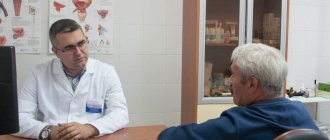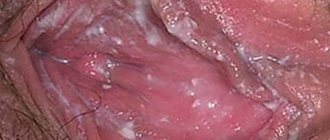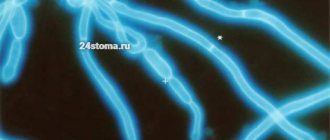Many are sure that candidiasis is a purely female disease, but this is not so. The disease can manifest itself in both sexes, only in men candidiasis is most often asymptomatic. The occurrence of thrush is caused by the proliferation of microscopic yeast-like fungi Candida. They are present in small quantities in every body, but with a decrease in immunity and under the influence of many other factors, their number can increase to the point of visual manifestation.
Causes of thrush in men
The causes of candidiasis in men are different, but all one way or another lead to the proliferation of the Candida fungus:
- weak immunity;
- lack of hygiene;
- as a result of unprotected sexual intercourse;
- long-term use of medications/antibiotics;
- sudden change in climatic conditions;
- presence of depression, stress;
The cause may also be a dysfunction of the intestine, as well as its microflora due to damage to the mucous membrane and the development of an inflammatory reaction.
Modern ideas about the treatment of urogenital candidiasis
Urogenital candidiasis is a fungal disease of the mucous membranes and skin of the genitourinary organs, caused by yeast-like fungi of the genus Candida.
Currently, more than 170 biological species of yeast-like fungi have been described, of which the causative agents of urogenital candidiasis are: C. albicans - in 80% (abroad - in 45-70%), C. glabrata - in 15-30%, C. tropicalis, C. krusei, C. parapsilosis - in 4–7% of cases.
The disease affects both men and women, but is more common in women of reproductive age. In terms of prevalence, vulvovaginal candidiasis ranks second among all vulvovaginal infections. The peak incidence is observed at 20–45 years of age.
Sexual transmission of infection occurs in 30–40% of cases. More often (60–70%) the disease is caused by endogenous infection. During pregnancy, the incidence increases by 10–20%; the risk of transmission of infection to the newborn during childbirth is approximately 70–85%.
Risk factors usually include pregnancy, the use of hormonal contraception and hormone replacement therapy (especially first-generation hormonal drugs), long-term and unsystematic use of antibiotics, immunosuppressants, cytostatics and some other drugs. However, it should be noted that antibacterial agents act as a risk factor only against the background of existing candidiasis and their effect is short-lived. Disorders of carbohydrate metabolism caused by diabetes mellitus contribute to the persistent course of urogenital candidiasis with frequent relapses that are difficult to treat.
Immunodeficiency conditions, systemic diseases leading to immune deficiency, also provoke the occurrence and recurrence of urogenital candidiasis. Candida infection is especially severe in HIV-infected patients. Often, in the terminal stage of AIDS, a generalized candida infection develops.
The main pathogenetic factors traditionally include an imbalance of the vaginal microflora, an increase in the concentration of estrogen and progestins in the tissues, and a violation of the local immunity of the genital tract.
Vulvovaginal candidiasis is the most commonly used name for the disease, since its main clinical manifestations are vulvitis and vaginitis. However, according to localization, candidal cervicitis, colpitis, urethritis, and bartholinitis are also distinguished. According to the nature of the course of the disease, they are distinguished:
- acute (fresh, sporadic) candidiasis (lasts no more than 2 months);
- chronic, including: a) recurrent (at least 4 episodes per year); b) persistent (symptoms of the disease persist constantly, somewhat decreasing after treatment).
Acute genital candidiasis is characterized by a pronounced inflammatory picture. The main complaints and symptoms of vulvovaginal candidiasis are itching and burning, constant or worsening in the afternoon, evening, night, after a long walk, and in patients with atopic predisposition - under the influence of many different factors. In the area of the vulva and labia, the itching is usually intense and is accompanied by scratching. Severe, constant itching often leads to insomnia and neuroses. The feeling of itching and burning, pain, especially in the scratching area, interferes with urination and can lead to urinary retention. Soreness and a burning sensation in the vagina intensify during coitus and lead to fear of sexual intercourse and sexual dysfunction (dyspareunia).
The next symptom is leukorrhea. The leucorrhoea is not abundant, white, thick (creamy) or flaky, curdled, filmy, and has a faint, sour odor. They are rarely watery, with cheesy-crumby inclusions. May be completely absent.
When nearby skin is affected, hyperemia, maceration of the skin, individual pustular elements, and itching in the anus are noted.
In patients with a predisposition, candidiasis often recurs, that is, the disease returns after complete extinction of clinical manifestations and restoration of impaired mucosal functions during treatment. If such relapses occur at least 4 times a year, the disease is classified as chronic recurrent vulvovaginal candidiasis. Treatment tactics in this case differ from those for sporadic episodes.
Another form of chronic infection is persistent vulvovaginal candidiasis, in which clinical symptoms persist constantly and only subside somewhat after treatment. Relapses should be distinguished from exacerbations, which develop not after the disease, but against the background of persistent clinical symptoms. Of course, the approach to treatment in this case is somewhat different than in other forms.
If previously the chronicization and recurrence of the disease was explained by reinfection (either endo- or exogenous), now the cause of these phenomena is considered to be the state of the macroorganism, since the same strain of the fungus is constantly released.
In foreign literature, the terms “complicated” and “secondary” vulvovaginal candidiasis are often used. Complicated includes both chronic forms and atypical etiology, pronounced clinical manifestations, course against the background of severe predisposing conditions (diabetes mellitus, cancer, blood diseases, immunodeficiency, including HIV infection), i.e. cases that are difficult to treat .
Secondary vulvovaginal candidiasis usually includes cases of infection occurring against the background of existing non-infectious lesions of the genital organs with lichen planus, Behcet's disease, pemphigoid.
As a rule, symptoms of candidiasis develop quickly, a week before menstruation, and subside somewhat during menstruation. In the chronic persistent form, their intensity increases.
In terms of differential diagnosis, the other two most common vaginal infections, bacterial vaginosis and trichomoniasis, have similar symptoms.
Symptoms of bacterial vaginosis usually appear in the first week of the menstrual cycle and go away on their own in the middle of the cycle. Recurrence of bacterial vaginosis sometimes follows recurrence of vaginal candidiasis.
Acute trichomoniasis is characterized by itching and a more pronounced burning sensation. The discharge is usually more abundant, liquid, and foamy.
Microscopy of a native preparation or a stained smear is the simplest and most accessible method for identifying the fungus, its mycelium and spores. Cultural diagnosis is recommended only in certain cases:
- to confirm the diagnosis with a negative microscopy result and the presence of a typical clinic;
- for species identification in cases of suspected atypical etiology;
- to determine sensitivity to antimycotics (usually together with species identification).
Isolation of more than 1•104 CFU/ml in the absence of clinical symptoms is regarded as asymptomatic colonization (candidate carriage), and treatment is not prescribed (10–25% of the population are transient carriers of Candida in the oral cavity, 65–80% in the intestines, 17% in the detritus of gastroduodenal ulcers). However, in the presence of predisposing (provoking) factors (for example, antibiotic, chemotherapy, radiation, steroid and other immunosuppressive therapy), prophylactic (preventive) treatment is often carried out. Nystatin is a widely used prophylactic drug. However, it is effective for the prevention of candidiasis only in the intestinal lumen. Its systemic absorption is no more than 3–5%, so it is not able to affect fungi that are not in the intestinal lumen. To prevent urogenital candidiasis, preference is given to local forms of antimycotics (vaginal tablets and suppositories, solutions and ointments). In the prevention of candidiasis in people suffering from serious diseases that are considered as predisposing factors (diabetes mellitus), only systemic azole drugs and amphotericin can be really effective.
Anti-candidal drugs include:
- polyenes - nystatin, levorin, amphotericin;
- imidazoles - ketoconazole, clotrimazole, miconazole, bifonazole, isoconazole;
- triazoles - fluconazole, itraconazole;
- others - flucytosine, nitrofungin, decamine, iodine preparations, etc.
Most cases of vulvovaginal candidiasis can be treated with local antifungals and antiseptics.
The advantage of local agents is safety, since systemic absorption is practically small, at the same time very high concentrations of the antimycotic are created directly in the affected area, i.e. on the surface of the mucosa.
Vaginal creams are recommended for the treatment of vulvitis, tablets and suppositories - for vaginitis.
When treating pregnant women, local antimycotics, if indicated, can be prescribed only in the second and third trimesters. Systemic antimycotics are not recommended during pregnancy.
Quite often, with vulvovaginal candidiasis, concomitant infections or disturbances in the vaginal microbiocenosis are observed. In such cases, combination drugs are used, which are highly clinically effective and can be successfully used in the treatment of vulvovaginitis of mixed etiology. Among these drugs, the most popular are:
- travocort - isoconazole nitrate + difluorocortolone-21-valerate;
- Klion-D - miconazole + metronidazole;
- Macmiror complex 500 - nystatin + nifuratel;
- polygynax - nystatin + neomycin + polymyxin;
- terzhinan - nystatin + neomycin sulfate + ternidazole + prednisolone.
However, combined forms are not recommended for use abroad, since, according to some researchers, they worsen pharmacokinetics due to competition between the components of the combined drug. In such cases, preference is given to a combination of local treatment with systemic treatment.
Local antiseptics are also used in the treatment of vulvovaginal candidiasis:
- solutions of soda, boric acid, sodium tetraborate, potassium permanganate (for douching and tampons), aniline dyes (for lubrication in mirrors);
- suppositories - povidone-iodine (betadine, vocadine, iodoxide) - at night;
- vaginal capsules - boric acid 600 mg/day;
- corticosteroid creams (classes I and II).
For severe vulvitis, warm baths with soda and local corticosteroid creams of classes I and II are prescribed. Excellent results during therapy can be achieved by using Travocort cream, which contains the antimycotic isoconazole in combination with the class II corticosteroid diflucortolone-21-valerate, for severe vulvitis. This optimal combination allows you to quickly relieve symptoms in women and especially men. This cream is easy to use, as it is prescribed only once a day (at night) for women and 2 times (morning and evening) for men. Travocort is odorless and does not stain laundry.
Highly active corticosteroid ointments of classes III and IV are not recommended, as they can lead to exacerbation and worsening of symptoms. Pathogenetic therapy also includes the use of antihistamines and ketotifen.
In persistent cases and with disseminated candidiasis, preference is given to systemic therapy, and in some cases to a combination of systemic and local treatment.
Fluconazole drugs are the “gold standard” in the treatment of patients with candidiasis. Itraconazole and ketoconazole are also used to treat this pathology.
During pregnancy and lactation, the use of systemic drugs is not recommended, and the references to positive results in some works have not been proven by a sufficient number of observations and scientific studies.
The duration of systemic therapy for uncomplicated vulvovaginal candidiasis is minimal (single dose, or oral medications for no more than 5 days).
The general recommendation for the treatment of complicated forms is to lengthen the course of therapy (the volume of local and systemic therapy is doubled).
Based on our own experience, we have proposed treatment regimens for uncomplicated and complicated vulvovaginal candidiasis (Table).
Our observations indicate that the most adequate methods for preventing relapses are using both local and systemic drugs.
Treatment of chronic recurrent vulvovaginal candidiasis
- Initial course: mycoflucan (fluconazole) 50 mg daily for 14 days or 150 mg once every 3 days for 2 weeks (a total of 14 tablets of 50 mg or 5 tablets of 150 mg per course).
- Preventive course: mycoflucan (fluconazole) 150 mg once a week for 3–4 months.
Treatment of persistent vulvovaginal candidiasis
The initial course is the same as for chronic recurrent candidiasis. Maintenance therapy consists of constant use of anti-candidiasis drugs: fluconazole (mycoflucan), 150 mg tablets, 1–2 times a month for 12–24 months.
In the treatment of antimycotic-resistant candidiasis, if therapy is ineffective, it is necessary to re-confirm the diagnosis by culture and isolation of the pathogen, followed by determining its type and sensitivity to antifungal drugs. The choice of systemic or local antimycotic and its dose is then carried out in accordance with the results of the study.
After re-confirming the diagnosis, it is possible to switch to local therapy with antifungals or antiseptics, prescribed in high doses, often and in long courses.
It is also advisable to use vitamin complexes containing biotin.
N. V. Kungurov , Doctor of Medical Sciences, Professor N. M. Gerasimova , Doctor of Biological Sciences, Professor I. F. Vishnevskaya Ural Research Institute of Dermatovenereology and Immunopathology of the Ministry of Health of Russia, Yekaterinburg
What type of thrush does it have in men?
Candidiasis in men most often appears on the head of the penis, causing irritation, pathological discharge and redness. Thrush often occurs in men with uncircumcised foreskin. In this case, the fungus receives more favorable conditions for life and reproduction. When candidiasis occurs, characteristic signs are observed - unpleasant itching and the appearance of a white coating on the mucous membrane. You can determine the disease yourself; you just need to know what it looks like on your underwear. Thrush leaves a thick white or yellow coating on panties.
Manifestation of candidiasis in the stronger sex
Due to the special structure of the male organ, as well as with a healthy lifestyle, regular hygiene and culture of sexual relations, candidiasis in the stronger sex, if it occurs, is asymptomatic. When symptoms appear, the patient may notice:
- feeling of pain when urinating, during sexual intercourse;
- the appearance of redness on the head of the penis and the lower foreskin, swelling is possible;
- constant feeling of itching and burning;
- a cheesy coating on the mucous membrane of the genital organ, a feeling of sour odor.
All this is a reason to contact a specialist. Perhaps thrush is only an indirect sign of another disease.
Manifestation of thrush in men
The appearance of characteristic signs of the disease in men is determined by the location of the lesion. If candidiasis appears on the skin, blisters and redness form, and on the mucous membranes - a type of infectious lesion.
The main symptoms of thrush in men are:
- unpleasant sensation of burning and itching;
- swelling of the penis appears;
- pathological discharge with an unpleasant odor appears;
- pathological secretion during urination, similar in appearance to seminal fluid;
- pain and discomfort during sexual intercourse;
The disease has an incubation period, and diagnosis and treatment depend on its duration. Most often this period lasts 2-3 weeks. During this time, symptoms may not appear, but the fungi are already multiplying in the body.
Causes of infection
Candida microorganisms are always present on human skin and mucous membranes. This situation is considered normal. When the immune system is abnormal, the balance of bacteria is disrupted, and fast-growing microorganisms begin to multiply sharply.
Despite the ubiquitous existence of microbes over the entire surface of the human body, their favorite places of reproduction are the genitals, interdigital space, armpits, and oral cavity. Depending on the site of infection, candidiasis in the mouth may occur - scientifically called candidal stomatitis. As for men, the place under the foreskin is most susceptible to the growth of yeast flora.
Risk factors and causes of candidiasis are as follows:
- poor hygiene and unhealthy diet;
- undergoing hemodialysis;
- too frequent and intensive use of cleansing bath products;
- increased glucose levels in poorly controlled diabetes mellitus;
- treatment with immunosuppressants and any other suppression of the immune system by drugs, which reduces the body’s protective functions;
- receiving chemotherapy or radiation therapy, taking antibiotics, corticosteroids.
It is possible to become infected during unprotected sexual intercourse, despite the fact that candidiasis is not recognized as a guaranteed sexually transmitted infection.
Treatment of thrush in men
Treatment of candidiasis is always completely individual. The course of therapy is prescribed only by a urologist or dermatovenerologist. He assesses the patient’s medical history, age and lifestyle, and then prescribes the necessary treatment. It is strictly prohibited to treat candidiasis at home without going to the doctor. This can lead to complications.
To make a final diagnosis, the patient must take a smear to examine the bacterial flora. In addition to this, several more tests may be prescribed:
- donating blood and genital swabs;
- determination of blood glucose levels;
- blood for HIV;
- general blood and urine analysis.
In case of candidiasis due to other reasons, the necessary treatment is required from highly specialized specialists. If no other pathologies are found, a course of therapy is prescribed and the patient is sent home for treatment.
Men get sick 4 times less often than women, so the choice of drugs for the stronger half of humanity is much smaller. For local treatment, antifungal ointments are used, and tablets that kill the fungus are taken orally. Among the ointments one can highlight pimafucin, clotrimazole, nystatin and others.
What drugs are used to treat the disease?
To overcome this disease, the patient is prescribed antifungal drugs. They can be in the form of ointments or tablets, the ingestion or external use of which can regulate the number of pathogenic microorganisms.
The most commonly used drugs are based on the following substances:
- Miconazole. It comes in the form of a spray or cream. When applied, it disrupts the integrity of various pathogenic microorganisms.
- Ketoconazole. Presented in the form of creams, sprays, tablets. A decrease in the fungal population occurs due to a destructive effect on the biosynthesis of some components of the fungal cell membrane.
- Econazole It comes in the form of creams. It affects the lipid structure of the fungal membrane, having a bactericidal and fungicidal effect.
- Clotrimazole. Presented in the form of creams, ointments and solutions. It has a positive effect on yeast and mold fungi, kills gram-negative and gram-positive bacteria, dermatophytes.
Features of candidiasis in men and women
Stereotypes imposed by the media and advertising lead many to consider thrush to be a female disease only. However, this is far from true: men also experience candidiasis, although much less frequently.
According to statistics, 3 out of 4 women under 25 have encountered this problem at least once, and every second woman who has had the disease experiences relapses. The lower prevalence of the disease among men is due to the structure of the genital organs.
40% of men are carriers of bacterial infection. Microorganisms are present in minimal quantities and practically do not cause harm to health. The fungus begins to manifest itself during periods of a sharp weakening of the immune system, stress or overwork.
Fungi of the genus Candida are located in the intestines, mouth, and genitals.
Diagnostics
If you notice signs similar to candidiasis, you should consult a doctor. Without laboratory research methods, it is impossible to establish an accurate diagnosis. Trichomoniasis, gardnerellosis and other infections may have similar manifestations. Usually, for diagnosis, a smear is examined under a microscope or a bacteriological examination is performed - culture. This is especially important to do without delay when the first symptoms appear. After all, in the initial stage the disease is easier to treat.
Also, during diagnosis, it is advisable to determine the type of Candida
. There is no point in treating some types of candidiasis with over-the-counter tablets and suppositories. Sometimes candidiasis constantly makes itself felt, despite treatment. The reason for this may be the insensitivity of fungi to drugs. In such cases, a study is carried out to determine the sensitivity of candidiasis pathogens to antifungal drugs.
Frequently worsening candidiasis is also a reason to check your health status, and, above all, your immunity. Therefore, sometimes doctors recommend doing a series of tests, for example, extended culture for fungi, an immunogram with individual selection of immunomodulators.
Diagnosis and treatment
Thrush can be identified by the main symptoms of the disease, but a similar clinical picture is observed in other diseases, so only a doctor can make a final diagnosis.
Important: thrush does not go away on its own; the disease must be treated.
To make a diagnosis, laboratory – bacteriological and microscopic – studies are carried out. After deciphering the test results, the doctor prescribes a course of antifungal therapy.
The basis for diagnosis is the presence of fungal elements in the collected biomaterial. Bacteriological culture analysis allows you to determine the type and genus of fungi. This is necessary in order to correctly select antimycotic (antifungal) drugs.
Typically, topical medications are prescribed for treatment - creams and ointments that suppress pathogenic microorganisms. If such therapy is ineffective, the doctor prescribes general medications.
Nutrition rules and diet during treatment
For faster and more successful treatment of thrush, the following foods should be excluded from your daily diet:
- Blue cheese".
- Chocolate, ice cream and all sweet products.
- Alcoholic drinks, kvass, carbonated sweet drinks, coffee and tea, which promote the proliferation of candida.
- Smoked meats, fried, fatty and pickled foods, sweet fruits, canned food, semi-finished products and fast food containing “hidden” sugars.
- Mayonnaise, ketchup, vinegar, soy sauce, which increase the acidity of the body and contribute to the progression of the disease.
The patient’s diet during and after treatment for thrush must include:
- All kinds of spices (cinnamon, bay leaf, garlic, cloves).
- Lemons and lingonberries, which have an antifungal effect.
- Beets, cucumbers, carrots, Brussels sprouts, broccoli, parsley, dill are the most unpleasant vegetables for fungus.
- Natural yoghurts, boiled liver, eggs, seafood, olive and flaxseed oil, wholemeal bread, sesame seeds, pumpkin seeds.
- Chamomile, plantain, alfalfa, string leaves, clover, blackcurrant and rowan berries - brewed and consumed as teas.
- Carrot juice and seaweed, which create an unfavorable environment for fungal growth.
- Vegetables (fresh and stewed), legumes and grains, fish and poultry, fruits (not very sweet - green apples, plums, etc.).
You should adhere to these nutritional principles both during treatment for thrush and for at least 2-3 weeks after its completion.
Complications
Lack of timely treatment can lead to disruption of the structure of the urethral mucosa, which will complicate the process of urination. The long course of the disease reduces the sensitivity of nerve endings, which leads to loss of pleasure from sexual intercourse. It is much more difficult for a man to achieve orgasm, against the background of which libido disappears and sexual dysfunction may develop.
To avoid consequences, you should consult a doctor immediately after detecting symptoms of candidiasis and follow the treatment recommendations prescribed by a specialist.
Important: traditional methods are extremely ineffective in treating fungal infections. Neglecting the methods of official medicine aggravates the course of the disease and leads to the development of complications.
Treatment
Treatment of candidiasis is prescribed after diagnostic procedures (microscopic and cultural examination of discharge) confirm the presence of the disease. Antifungal therapy is only appropriate when the yeast count exceeds 102 CFU/ml. Before starting to use a particular drug, it is recommended to determine the species of the fungus and its sensitivity to antimycotic drugs. Treatment of candidiasis in women and men is carried out in a complex that includes a number of the following measures:
- use of antifungal drugs (local or systemic);
- the use of nonspecific agents that promote maximum removal of the fungus from the mucous membranes;
- exclusion of re-infection (observance of personal hygiene rules, use of barrier methods of contraception).
At the end of treatment, to restore normal microflora, it is recommended to use vaginal probiotics containing beneficial lactobacilli.
Diagnosis of thrush
Manifestations of mammary glands in men can be confused with other urogenital diseases and infections. Prescribe medications. In order to quickly and effectively treat the mammary gland in men, it is necessary first of all to accurately identify all infectious pathogens.
Diagnosis of male candidiasis includes:
- collection of smears and their microscopic examination;
- PCR;
- ELISA;
- laboratory diagnostics of blood and urine.
If necessary, specialists prescribe ultrasound examinations of the genitourinary organs. Masks from the urethra are removed in the morning before the first urination. All sexual partners should undergo appropriate testing and treatment. This minimizes the risk of re-infection and relapse of diseases in the future.
When the mammary gland is combined with balanoposthitis and an increase in the number of leukocytes and bacteria during smear microscopy, it is necessary to conduct a PCR study and identify specific infectious agents.
The danger of candidiasis
Thrush is not a dangerous condition, since it does not relate to any particular disease and cannot affect the condition of the cervix and vaginal walls in women. The occurrence of a condition such as candidiasis indicates a disruption in the functioning of the body. Therefore, recurring thrush requires an examination to find out the cause of its occurrence. If you get rid of the cause, you can forget about the further appearance of candidiasis.










